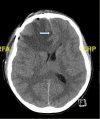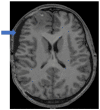Bacterial Brain Abscess and Life-Threatening Intracranial Hypertension Requiring Emergent Decompressive Craniectomy After SARS-CoV-2 Infection in a Healthy Adolescent
- PMID: 37073194
- PMCID: PMC10105642
- DOI: 10.7759/cureus.36258
Bacterial Brain Abscess and Life-Threatening Intracranial Hypertension Requiring Emergent Decompressive Craniectomy After SARS-CoV-2 Infection in a Healthy Adolescent
Abstract
Acute coronavirus 2 (SARS-CoV-2) infection usually results in mild symptoms, but secondary infections after SARS-CoV-2 infection can occur, particularly with comorbid conditions. We present the clinical course of a healthy adolescent with a brain abscess and life-threatening intracranial hypertension requiring emergent decompressive craniectomy after a SARS-CoV-2 infection. A 13-year-old healthy immunized male presented with invasive frontal, ethmoid, and maxillary sinusitis and symptoms of lethargy, nausea, headache, and photophobia due to a frontal brain abscess diagnosed three weeks after symptoms and 11 days of oral amoxicillin treatment. Coronavirus disease 2019 (COVID-19) reverse transcription-polymerase chain reaction (RT-PCR) was negative twice but then positive on amoxicillin day 11 (symptom day 21), when magnetic resonance imaging revealed a 2.5-cm right frontal brain abscess with a 10-mm midline shift. The patient underwent emergent craniotomy for right frontal epidural abscess washout and functional endoscopic sinus surgery with ethmoidectomy. On a postoperative day one, his neurological condition showed new right-sided pupillary dilation and decreased responsiveness. His vital signs showed bradycardia and systolic hypertension. He underwent an emergent decompressive craniectomy for signs of brain herniation. Bacterial PCR was positive for Streptococcus intermedius, for which he received intravenous vancomycin and metronidazole. He was discharged home on hospital day 14 without neurological sequelae and future bone flap replacement. Our case highlights the importance of timely recognition and treatment of brain abscess and brain herniation in patients with neurological symptoms after SARS-CoV-2 infection, even in otherwise healthy patients.
Keywords: bacterial; brain abscess; child and adolescent; elevated intracranial pressure; infection; intracranial hypertension; sars-cov-2; sinusitis.
Copyright © 2023, Kunapaisal et al.
Conflict of interest statement
The authors have declared that no competing interests exist.
Figures






Similar articles
-
A Unique Triad of Invasive Sinusitis, Brain Abscess with Focal Cerebritis, and COVID-19.Am J Case Rep. 2021 Oct 27;22:e933177. doi: 10.12659/AJCR.933177. Am J Case Rep. 2021. PMID: 34702794 Free PMC article.
-
Decompressive craniectomy for severe traumatic brain injury: Evaluation of the effects at one year.Crit Care Med. 2003 Oct;31(10):2535-8. doi: 10.1097/01.CCM.0000089927.67396.F3. Crit Care Med. 2003. PMID: 14530763
-
Post-COVID-19 Multisystem Inflammatory Syndrome-Related Cerebral Infarction in a Pediatric Patient Managed with Decompressive Craniectomy.Pediatr Neurosurg. 2023;58(1):53-57. doi: 10.1159/000529682. Epub 2023 Feb 15. Pediatr Neurosurg. 2023. PMID: 36791681
-
Brain abscess due to Aggregatibacter aphrophilus in association with atrial septal defect:Case report and literature review.Clin Neurol Neurosurg. 2022 Aug;219:107337. doi: 10.1016/j.clineuro.2022.107337. Epub 2022 Jun 11. Clin Neurol Neurosurg. 2022. PMID: 35717764 Review.
-
Intracranial hypertension secondary to sigmoid sinus compression by group A streptococcal epidural abscess.J Laryngol Otol. 2010 Jan;124(1):93-5. doi: 10.1017/S0022215109990764. Epub 2009 Aug 3. J Laryngol Otol. 2010. PMID: 19646300 Review.
Cited by
-
A Report of Two Cases of Meningoencephalitis Caused by Streptococcus intermedius.Infect Drug Resist. 2024 May 31;17:2189-2198. doi: 10.2147/IDR.S438615. eCollection 2024. Infect Drug Resist. 2024. PMID: 38835493 Free PMC article.
References
-
- Coronavirus cases. [ Jan; 2023 ]. 2023. http://srv1.worldometers.info/coronavirus/coronavirus-cases/ http://srv1.worldometers.info/coronavirus/coronavirus-cases/
-
- Centers for Disease Control. COVID data tracker. [ Jan; 2023 ]. 2023. https://covid.cdc.gov/covid-data-tracker/ https://covid.cdc.gov/covid-data-tracker/
Publication types
LinkOut - more resources
Full Text Sources
Miscellaneous
